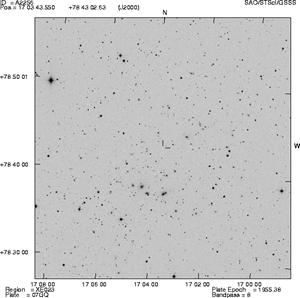(see also Project A7 DFG Research Unit Magnetisation of Interstellar and Intergalactic Media - The Prospects of Low-Frequency Radio Observations)
In the
framework of this project, we study the diffuse
radio continuum emission in galaxy clusters. In contrast to currently
active
galaxies (AGN of all kinds), which produce fresh relativistic
particles, we are
tracing here the relics of previously relativistic particle pools,
which are
rendered visible via synchrotron radiation after reacceleration in
cosmological
shocks. These shocks are created in mergers of galaxy clusters, mostly
at the
contact surface of their encountering peripheries. They lead to
extended radio
sources characterized by strong polarization. A prominent example is
shown
below. The optical image (SDSS)
shows the
galaxy cluster A2256, and the 21-cm radio continuum map (Röttgering
et al. 1994) obtained with the WSRT is placed on the
right.
The very peculiar and sharp radio structures reflect synchrotron
radiation
produced in a shocked region where in infalling sub-cluster compresses
the
magnetic field and re-accelerates the aged relativistic particles. The
radio
structures are characterized by strong linear polarization, as manifest
in the
right-most image, showing the emission at 2.8 cm wavelength obtained
with the Effelsberg
100-m
telescope. The ‘vectors’ have lengths proportional to the polarized
intensity.
Other relic
sources, formerly called `radio halos',
are restricted to the cluster centres. They lack polarization and the
processes
creating them are less obvious. One of the likely processes is
turbulent wakes
created by the motion of galaxies through the cluster medium. The most
prominent example of a cluster radio halo is that of the Coma Cluster,
investigated by Venturi
et al. (1990). The images below show the X-ray emission (left,
contours
superimposed onto an optical image) and the radio continuum at 90 cm
wavelength. Apart from the central halo, there is also a peripheral
radio
continuum structure located right where a sub-cluster is falling in the
south-west. Apart from some discrete cluster radio sources (typically
head-tail
structures), there are numerous unrelated background objects that stick
out in
this long-wavelength regime because of their steep synchrotron spectra.
In the
peripheral relics, the re-acceleration
mechanism is most likely to be sought in the shocks produced in the
course of
cluster merging. For the central radio halos this is less clear. One
possibility is that the relativistic electrons are re-energized by
galactic
wakes, as the central galaxies are floating through the plasma. An
alternative
is that we see synchrotron radiation from secondary electrons, which
are
produced as end products of collisions of relativistic protons which
collide
with the thermal protons or ions in the dense and hot gas in the centre
of
clusters (see illustration below). These inelastic collisions produce
neutral
pions, which decay into γ-rays, and charged ones, which decay into
muons. These
ultimately decay into positrons and electrons. The chains then are
(particles*
are antiparticles)
p + p → p + p
+ π+
+ π-
π± → π±
+ νμ/ ν*μ
→ e± + νe/ ν*e + νμ
+ ν*μ
n → p + e-
+ ν*e
The final
particles are relativistic, owing to the
large energies of the primary protons. Interestingly, such hadronic
collisions
will primarily produce relativistic positrons, owing to the
preponderance of
protons (over neutrons).
Finally,
there may be large numbers of exhausted radio
sources, with `starved' AGN. These may be only found at the lowest
radio
frequencies. Once detected, they must be studied in depth in order to
obtain
their physical parameters, i.e. particle ages in the first place. A
prototypical example of such a died radio galaxy is B2 0924+30 was
studied at
five wavelengths by Jamrozy
et al. (2004).
From the
intensity decrease, characterized by a
steepening of the synchrotron spectrum towards higher frequencies, one
can
determine the age of such a source (also for cluster halos and relics).
This
age corresponds to the half-lifetime of the radiating particles
(electrons
and/or positrons), which suffer energy losses via the synchrotron and
Inverse-Compton process. The break-frequency νb determines
the age τ
in a given magnetic field of strength B,
corresponding to the cut-off energy of the relativistic particles,
according to

Here, BCMB
is the strength of a magnetic field the energy density of which would
be
equivalent to that of the CMB radiation,

By measuring
the synchrotron radiation of cluster relic
sources over a large frequency range using single-dish telescopes as
well as
interferometers, one can derive a number of important physical
parameters of
the relativistic constituent in galaxy clusters (magnetic field,
particle
density, energy spectrum) and to disclose regions of cosmological
shocks
resulting from cluster merging. This provides an independent tool to
trace
large-scale structure formation in the local universe. The goals thus
are to
·
unveil the
shocked regions at the
contact zones of cluster mergers
·
and determine
their physical
parameters,
·
detect radio
halos in the central
regions of clusters,
·
detect
exhausted radio sources,
·






